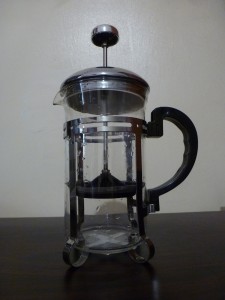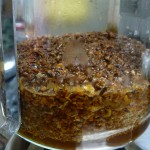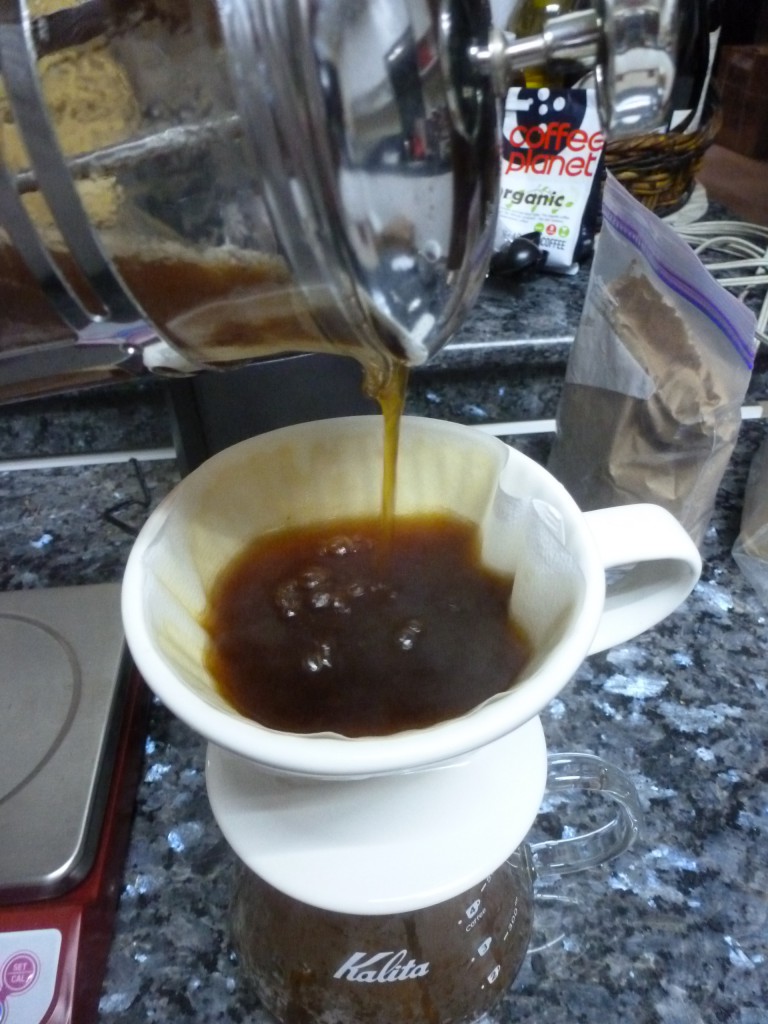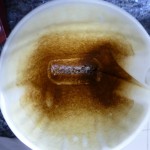 I have an old French Press coffee maker at home. It looked like it had seen better days, so I decided to clean it up and give it a whirl and see if it made any good coffee. While looking at it’s overall design, I thought that it was a classic that went all the way to the earliest days of making coffee. But after further reading, I was astonished to find out that it actually has a relatively short history.
I have an old French Press coffee maker at home. It looked like it had seen better days, so I decided to clean it up and give it a whirl and see if it made any good coffee. While looking at it’s overall design, I thought that it was a classic that went all the way to the earliest days of making coffee. But after further reading, I was astonished to find out that it actually has a relatively short history.
Coffee Presses were first patented in 1929 by a Milanese designer named Attilio Calimani. After several design changes by Faliero Bondanini, he once again patented it in 1958. And began mass manufacturing of the coffee press in 1958 where it’s popularity grew.
We could even probably celebrate the French Press 100 year anniversary come 2029.
Anyway enough of the history lesson, on with the French Press…
The French Press is a well made coffee maker that makes brewing very simple. It’s basically putting all the ingredients in the carafe and giving the water time to extract the coffee flavor. The longer you immerse the coffee in the water, the stronger your coffee will taste. It seems simple enough; however, I must admit that my first brews didn’t produce the best type of coffee that I thought it would make. So I had to make experiments and adjustments until I came up with a pretty good mug with the French Press.
Before we begin, let’s look at what type of coffee the French Press makes
Unlike the pour-over method, the French Press tends to produce a more full bodied coffee, meaning that we feel that the coffee is heavier when it enters our mouths. That’s because the natural oils of the coffee grounds are not filtered out. And also because coffee made from French Presses have more sediments.
It also extracts more flavor from the coffee grounds because the coffee is in contact with water for a longer period of time, allowing you to extract more of the fruity, acidic, nutty, chocolate, and bitter flavor out of the coffee beans.
On the downside, the coffee produced by a French Press tends to have more residue. Residue is also known as coffee fines, sludge, or silt. So because of this residue, most people just don’t drink the remaining coffee at the bottom of the cup. On some cases though (as I found out for myself),depending on how fine this residue is, you could still taste or feel it while you’re enjoying your cup of coffee, turning it from a great into an unpleasant experience.
Now this is the point where preference comes in, because some people like to have that full body flavor, while others will like the cleaner cup that pour over’s produce.
Because of this, I have tweaked the way I prepare my French Press coffee.. So onto the preparation!
Preparing to make a great cup of French Press coffee
I learned that a good cup of coffee always comes with proper preparation. The good thing about this preparation is that you only need to do the preparation once, leave it at your coffee brewing table, and you can repeat the process every time you make coffee. Below is a list of the items we’ll need. I have divided them into necessary (for making a cup of coffee) and optional (to produce a cleaner cup afterwards):
Necessary Items:
- Fresh roasted coffee
- Burr Grinder
- Filtered water at 195-205 degrees Fahrenheit or water about 20-30 seconds just off the boil
- French Press
- Weighing Scale
- Timer

Optional Items:
I happen to have these items hanging around and got inspiration from the Clever Coffee dripper.
 Any pour over dripper. You could use any manual dripper you have around, or even use the one attached to your auto drip machine.
Any pour over dripper. You could use any manual dripper you have around, or even use the one attached to your auto drip machine.- Paper or metallic filter
- Carafe/Mug to pour the clean coffee in
Now that we have our items prepared, let’s move on over to the actual brewing.
From zero to French Press Coffee
Step 1: Get the proper weight of coffee beans.
Note: The amount of coffee you use depends on the roasters specification. If there is none written, a general good coffee-to-water ratio plays between 1:14 and 1:16. So start with 1:15 (ex: 10 grams of coffee per 150 grams of water) and add/reduce depending on your taste on future brews.
Step 2: Start boiling your water
Step 3: While the water is boiling, pre-heat your French Press.
Note: Putting warm water on the carafe will keep it warm so the initial dose of water on the brew doesn’t cool down.
Step 4:  Grind the coffee beans. Set the grind size to medium coarse to coarse, sea salt size.
Grind the coffee beans. Set the grind size to medium coarse to coarse, sea salt size.
Step 5: Once the water boils, turn off the heat and let it sit for an additional 20 seconds before using it. If you’re transferring to another kettle, the water temperature would have cooled down already so in this case, you should start using it right away. This would give you the perfect temperature in brewing your coffee.
Step 6: Throw away the water in the carafe that you used for pre-heating.
Step 7: Put the ground coffee into the carafe and shake it a bit to settle.
Step 8: Place the French Press on the weighing scale, set it to 0 without the lid.
Step 9: Start your timer and add enough water just to saturate the coffee grounds (about 1 or 2 times the ground coffee weight) , allowing it to “bloom”.
Step 10: After 30-40 seconds, you can:
- Either swirl and break the coffee bloom, add the remaining water, and give it a little swirl at the top; or,
- Add the remaining water, then use a spoon to break the crust, and stir the contents

Step 11: Close the lid, but don’t plunge the coffee press. And wait for the timer to reach 4 minutes.
Note: I’d like to add that most experts give a brewing time of 4 minutes, but sometimes the coffee is still underextracted at this point. Nic Cho wrote in his guide that he made his grind sizes very coarse and his brewing time was 6-8 minutes. I tried this method and it gave a great tasting cup!

Step 12: Slowly plunge the coffee press. If you encounter a lot of resistance, just pull the press up a little and continue pushing down slowly.
Note: I found out that as the brew time takes longer, more coffee particles begin to submerge down the carafe. At a 6 minute brew time, a lot of the coffee grounds have gone down, which gave me a really good coffee.
And there you have it. Your French Press coffee ready to serve. But wait! Didn’t we want to make it into a cleaner cup? This is where the Optional Items come into play.
Making Cleaner French Press Coffee
- In about 30 seconds before your French Press is ready, start pre-wetting the filter and pre-heating the dripper. You could use paper or metallic filters. The paper filter will absorb a lot of the oil and the residue, while the metallic filter will absorb the residue but let the natural oil pass through.
- Once you’re coffee is done brewing. Pour the contents of the coffee in the French Press over to the dripper. No need for technique here, just pour it straight down the middle as you’re done brewing the coffee anyway. Pour it as high up the dripper as you can because you’d want to empty the French Press carafe of water as fast as you can, thereby not overextracting the coffee at the bottom of the press.

Now you have a coffee that’s as clean as the one you make with a pour over dripper, but with a taste that’s stronger and extracted like a French Pressed coffee!
 I’ve attached a small image of what the filter looked like after pouring the French Press coffee over it to show the residue and oils that were trapped by the filter. You can click on the thumbnail to see the larger image.
I’ve attached a small image of what the filter looked like after pouring the French Press coffee over it to show the residue and oils that were trapped by the filter. You can click on the thumbnail to see the larger image.
Taste Test
I couldn’t get a good camera shot at the results, but I put 2 cups side by side and tasted them. Do take note that I’m no coffee expert. I’m someone who just loves his coffee. Here are the results that I observed:
Coffee Straight from French Press
- Murky looking coffee with more texture due to the residue and oil
- Taste was good, but a little subdued
- A lot more body, and you could (for lack of a better term) “feel” the coffee parts
Filtered Coffee
- Coffee was clearer
- Flavors were strong and really popped out
- Coffee was very smooth. But lacked body as it didn’t stick to the tongue as long as the other one.
So the taste profile all boils down to preference. I wouldn’t mind both, but still have a slight inclination towards the cleaner and less residual cup. What is your preference?
As an additional note, I would probably not recommend this method during cold winter days as the coffee would get cold fast during winter, but for any other season, this method would work perfectly.
Like I said earlier, I got my inspiration from the Clever Coffee Dripper. You could probably buy one and save yourself a whole lot of trouble. But I have a lot of fun brewing my coffee this way, and friends who come over are amazed once they see and taste cleaner French Press coffee. So try it out yourself. You might have fun doing it too! Thanks for reading and leave a comment anytime.

Nice site full of great information.
Thanks for the comment Amanda 🙂 more how to’s and information will be coming 🙂 cheers!
Pingback: Third Wave Coffee Explained- from First to Third
Omg, I am so glad I found this website. I love coffeeeeeeeeee! My favorite coffee is one brewed over a campfire, it’s a rustic homefeel for me. I do love french pressed coffee though. Thanks for sharing these tips for me. I need to go buy a new french press that’s for sure.
Hey there Dane! Wow coffee over a campfire sounds so mice! We don’t get to do that where we are, but I’d sure like to try that someday 🙂 You’re welcome on the tips and thanks for visiting my site 🙂
This is some great information. I’m a coffee addict but I noticed by reading your information that I should be leaving my press for a little longer before plunging! I’ll be trying that in future!
Thank you 🙂
Thanks for the comment Emma 🙂 Yes I was surprised when I tried it too. It did make my cup better, just remember that you might need a coarser grind so you won;t overextract the coffee grounds
I have always used the French press to make coffee. Although I have just learned from you that I have been doing a few things wrong, thanks for pointing them out.
Hi Jason! Don’t worry about how you make French Press coffee 🙂 It all boils down to experimentation and trials since we all have different preferences to coffee anyway 🙂 These are just guidelines that you could tweak, so don’t be afraid to try different grind sizes and brew times out. Thanks for visiting and enjoy your coffee 🙂 More posts will follow on other ways of making coffee 🙂
I am a coffee lover and will always be. I have never had french press coffee and I intend to now. There is nothing else in this world any better than freshly brewed coffee. Your site is very helpful in so many ways. Thanks a bunch!
~Mary~
Thanks Mary 🙂
Great post, like the way you write 🙂
Thanks Angee 🙂 I’m glad you liked the post 🙂
Thanks for sending this process. I am knowing about how to make french press coffee. But I really didn’t know about this process. I think, It will be more easy. I should try to follow this processes.
No problem Anjelica, glad to help! Yes French press coffee is really quite easy, but tastes really good. It’s one of my favorites! If you want to have an easier time cleaning the press, try the Bonavita immersion brewer, it’s really cool! I’ll write a post about it soon. Thanks for checking out the site! Awesome comment too 😀
Thanks for this wonderful post, I love coffee very much and French press is one of my favourite …
Yes Tracy! I agree! Aside from making great tasting coffee, it’s less acidic than some other methods.
Nowadays, I’m usually making French press coffee. It’s so easy and enjoyable to make.
Darwin, Do you know that it affect the cholesterol level also? One of my friend’s doctor advised him to quit coffee due to high cholesterol level.
Really? Could it be possible that the cholesterol comes from the saturated fat in the creamers that we’ve been using? I’m no doctor so I really cannot confirm this. But still, good information. We really do need to have a good balance in life. Exercise, eating healthier, having less stress, are some good ways to try and combat cholesterol. I also have high cholesterol (genetics-based), but I’ve noticed with good cardio, my cholesterol levels go down to normal.